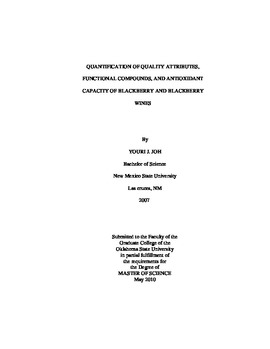| dc.contributor.author | Joh, Youri J. | |
| dc.date.accessioned | 2014-04-15T18:37:46Z | |
| dc.date.available | 2014-04-15T18:37:46Z | |
| dc.date.issued | 2010-05-01 | |
| dc.identifier.uri | https://hdl.handle.net/11244/8524 | |
| dc.description.abstract | The objective of the study was: (i) investigate two cultivars, Apache and Ouachita, and two growing locations, Central Arkansas and Eastern Oklahoma, in order to determine their possible influences on the quality and antioxidant capacity of whole berries and wine; (ii) measure antioxidant capacity of blackberries at different stage of processing-whole berries, juice, unracked wine, and racked wine; (iii) investigate consumer‟s preference for cultivar and/or growing location and assess the impact of winemaking technique on wine quality and antioxidant capacity. The Folin-Ciocalteu method was used to measure total phenolic contents and the pH differential method was used to evaluate total anthocyanin contents. Oxygen Radical Absorbance Capacity (ORAC) assays were also conducted in order to measure antioxidant activity. Qualitative tests such as pH, tiratable acidity, soluble solids were conducted to measure the quality of blackberry fruit. Sensory tests were also performed on whole berries in order to evaluate subjective impressions of quality. Whole berries had the highest total phenolics, total anthocyanins, and ORAC values, followed by juice and wines respectively. Blackberries rated higher in titratable acidity, pH and soluble solids were more preferred in terms of blackberry flavor. The Apache cultivar was preferred among Oklahoma-grown berries while the Ouachita cultivar was preferred among Arkansas-grown berries. Wine processing technique did not significantly affect the antioxidant capacity of blackberry wines; however, berries pressed after fermentation trended toward higher total phenolics while wines made by fermenting pressed juice were numerically higher in total anthocyanins and ORAC values. Oklahoma-grown berries showed slightly higher values for total phenolics, total anthocyanins, and ORAC values. Total anthocyanin content was strongly correlated with ORAC values in wine while total phenolics content was strongly correlated with ORAC values in whole berries and juice. Blackberry processing byproducts may be a good source of antioxidants given that substantial amounts of antioxidants appear to remain in the blackberry pomace after pressing. | |
| dc.format | application/pdf | |
| dc.language | en_US | |
| dc.publisher | Oklahoma State University | |
| dc.rights | Copyright is held by the author who has granted the Oklahoma State University Library the non-exclusive right to share this material in its institutional repository. Contact Digital Library Services at lib-dls@okstate.edu or 405-744-9161 for the permission policy on the use, reproduction or distribution of this material. | |
| dc.title | Quantification of Quality Attributes, Functional Compounds, and Antioxidant Capacity of Blackberry and Blackberry Wines | |
| dc.type | text | |
| osu.filename | Youri_okstate_0664M_10838.pdf | |
| osu.college | Agricultural Sciences and Natural Resources | |
| osu.accesstype | Open Access | |
| dc.description.department | Department of Animal Science | |
| dc.type.genre | Thesis | |
| dc.subject.keywords | antioxidant | |
| dc.subject.keywords | orac | |
| dc.subject.keywords | total anthocyanins | |
| dc.subject.keywords | total phenolics | |
